Looking to Lodi for Wine Values

Lodi has a reputation problem. (I'm not going to quote Credence Clearwater Revival, I'm not going to quote Credence Clearwater Revival.) Think of it as the breadbasket of the California wine industry. It leads among the state's winegrowing districts in the production of zinfandel, cabernet sauvignon, merlot, petite sirah, syrah, chradonnay, pinot grigio, and sauvignon blanc. But the bulk of those grapes historically have gone to make bulk wine, California wine, supermarket wine, wine sold before its time, and wines that fed the white zinfandel boom.
Those times have changed, though. People care about what they eat and drink now. While 20 years ago there were only eight wineries in Lodi, now there are 85. Boutique is big. "Many of the sites are families farming for four, five, six generations," Camron King, Executive Director of the Lodi Winegrape Commission, says. "Plus there's an entrepreneurial spirit of 'let's see what we can grow here.'" Turns out what Lodi can grow is 24% of the state's grape crop.
Note King is director of a growers' group, not a winemakers' group. The Commission began in 1991 as a way to market, research, and do outreach for the farmers of grapes, which led to the development of the Lodi Rules, a system of third-party verified sustainability few wine regions match. King says the impetus has consistently been, "How do we make things better for the next generation?"
One of the best benefits for future generations is the existence of some of California's oldest producing vineyards. For instance, Bechtold Vineyard features vines 129 years old -- when they call the Cinsault from the site ancient, that's far from advertising puffery. (FYI, the terms "old vines" and "ancient vines" have no legal, authorized standing -- vineyards can use them as they see fit, so beware.) These were planted when Grover Cleveland was president.
The resultant wines are so good that esteemed wineries like Turley, Scholium Project, and Bonny Doon use the fruit. Most of it goes to the vineyard's owner Michael David though, and they make a single site Cinsault bottling, for a mere $25, that's one of the more fascinating wines in the state. It's the lost link between pinot noir (that of sophistication and beauty) and zinfandel (that of richness heading to bramble). Of course, Michael David is most known for its mass market and brilliantly named 7 Deadly Zins -- Lodi at its value-priced best. Lodi can't stop being Lodi.
But that means King is correct when he says, "The quality that's being delivered at the price point -- we think we over-deliver." Such is certainly the case with many of the zinfandels from the region. Since the area is just east of the California Delta it still gets that cooling effect off the Pacific, while remaining quite warm, too. Plus it gets the sandy soils of the toes of the Sierra foothills, which King says, "Is perfect for old vine zinfandel." One great example is St. Amant Old Vine Zinfandel from a 101 year-old vineyard. At just $18 a bottle, it's a berry bomb with a backbone.